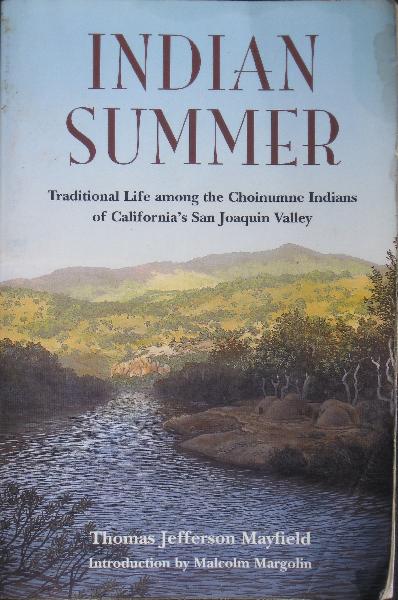
laindyindiansummer.jpg, image/jpeg, 2029x3058
The memories of a man who was raised by the Choinumne for 10 years in the mid-1800s.

laindyindiansummer.jpg, image/jpeg, 2029x3058
(Expanded from a post at the Montrose Peace Vigil discussion board http://montrosepeacevigil.proboards.com/.)
The San Joaquin Valley, as seen from the 5, always seemed dreary and monotonous to me, though I sometimes wondered if its past might have been more interesting. The book Indian Summer: Traditional Life Among the Choinumne Indians verified this hunch(1). In fact, one of the rest stops I've been to many times, Bravo Farms (Kettleman City), is very close to where Tulare Lake, the book’s setting, was (and sometimes partly returns during heavy rain).
In the early 1850s, Thomas Jefferson Mayfield spent 10 years of his childhood living with and being raised by the Choinumne Indians at Tulare Lake. For years at a time he only spoke their language. But for the rest of his life he refrained from talking about his experiences due to the climate of the time (e.g., the Choinumne were at war with the state of California not too long after he lived with them)--until the late 1920s, when local historian Frank F. Latta, recorded his memories. Thomas died before all the recollections could be preserved, but fortunately a huge amount of the recording was done. The work has only been published a few times, the most recent being in 1994.
The book describes many aspects of daily life, including house construction, interactions with neighboring peoples, hunting and gathering, cooking, domesticated animals, story telling, and child’s play. There is also a fair amount of vocabulary. (Apparently comprehensive vocabulary was collected independently of this book, too, when such information was gathered about other tribes in California by J.P. Harrington).
At times I found this book upsetting. Beyond the insidious acts committed against the Indigenous people, there is also the colossal alteration of the environment (much of it due to diversion of rivers for agriculture). Beyond the disappearance of Tulare Lake itself, forests of oak trees are long gone (one of them is illustrated circa the mid-1800s)(2), and the sky was crowded with birds. "I have seen the white geese with black wing tips flying so thick that I am positive one band of them could cover four square miles of land," Mayfield says.
The last few chapters of the book were especially hard to read because they focus on the takeover by Euro Americans. In fact, I had to hold off reading those parts. Maybe I’ll wait and read them on Fourth of July.
Reading Indian Summer rekindled my interest in another book, The Miwok in Yosemite: Southern Miwok Life, History, and Language in the Yosemite Region. This is a small publication put out by the Yosemite Conservancy in 1996, which I obtained a few years ago (www.goodreads.com/book/show/28936743-the-miwok-in-yosemite). This, too, is both edifying and upsetting.
Indian Summer is edited by Malcolm Margolin, who wrote his own book, the excellent The Ohlone Way about Bay Area Indigenous people (see: https://heydaybooks.com/book/the-ohlone-way-indian-life-in/) and also edited The Way We Lived (see: https://heydaybooks.com/book/the-way-we-lived/).
-----
(1)with help from A State of Change: Forgotten Landscapes of California by Laura Cunningham.
(2)More about the alteration of the San Joaquin Valley can be found in Laura Cunningham’s book A State of Change: Forgotten Landscapes of California, chapter 4 (which cites Indian Summer as a source). LA Indymedia discusses this book here: http://la.indymedia.org/news/2011/03/245172.php. While addressing Tulare Lake, Cunninham says, “The Spanish called it ‘tulare,’ the land of the tules” (p.77).
Original: Indian Summer: Traditional Life Among the Choinumne Indians